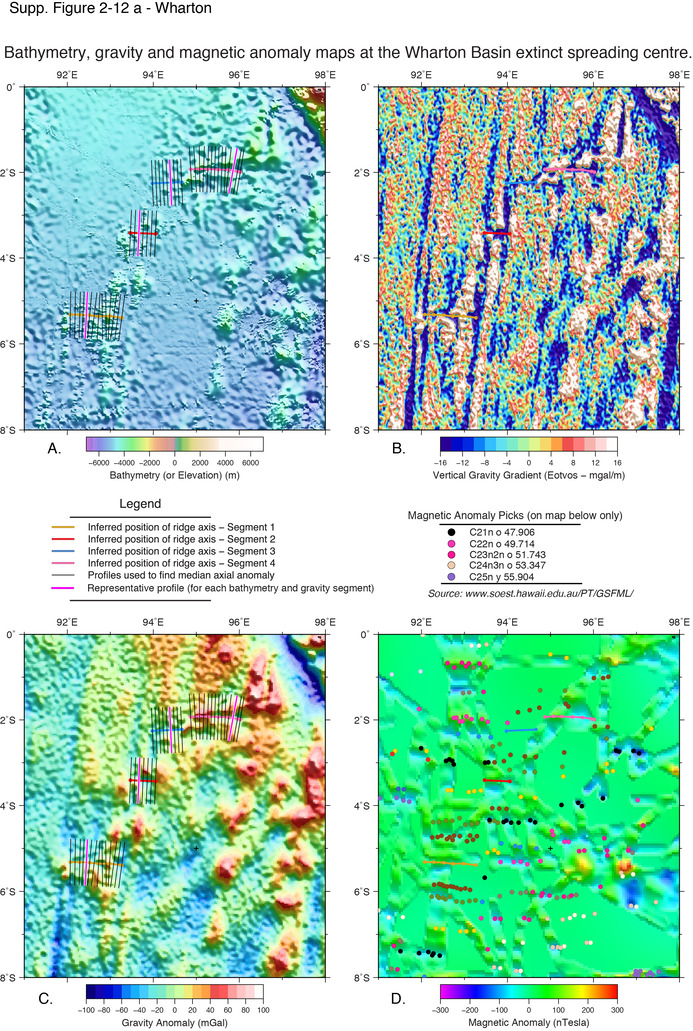| Ocean: | Indian |
| Spreading centre type: | Large-scale extinct MOR |
| Time of cessation: | 48 Ma, C21n (Hebert et al., 1999) |
| Subsequent active spreading centre: | Present-day South East Indian Ridge (SEIR) |
| Cessation style: | Appears to have been a protracted slow-down. |
| Later deformation or volcanism: | Fault reactivation has been reported and some volcanism at the Styx seamount is believed to post-date cessation of spreading (Hébert et al., 1999). |
The first comprehensive geophysical study of the region was undertaken by Larson et al. (1978), who discuss the depth anomaly in the south of the basin at the Wallaby-Zenith fracture zone, that they felt reflected a major change in spreading direction between 80 and 108 Ma. Larson (1979) then noted the complexity and lack of apparent chronological continuity between the West Australian offshore basins and the Wharton Basin. The segmented extinct ridge in the north of the Wharton Basin was first discussed in a Doctoral dissertation by J. M. McDonald in 1977, although this text was not available for our review, but is referred to by Liu et al. (1983), a publication which McDonald co-authored. The location of the extinct spreading centre segment-axes were inferred from observed basement highs. Liu et al. (1983) reported symmetric magnetic anomalies about the inferred axial segments and reviewed additional geophysical data that had become available.
Liu et al. (1983) observed that the spreading segments vary in length and suggested local asymmetric spreading or small-scale ridge jumps by individual spreading segments, such as has been reported at the SEIR near the Amsterdam-St. Paul hotspot (Royer and Schlich, 1988). Liu et al. (1983) proposed that a possible ridge jump may have occurred in the region of the Ninety East ridge, in the range of 11 ° to the south, at the time of anomaly 22 or 23 (Liu et al., 1983).
Recent studies have focused on later tectonic events, such as the intraplate deformation in this region and the re-activation of several of the spreading segments at present day (Carton et al., 2014; Delescluse and Chamot-Rooke, 2008). These studies demonstrate that the extinct ridge axis, an area of potential serpentinisation and weakened rheology may be vulnerable to later tectonic re-activation and in some cases volcanism. Hébert et al. (1999) also described the Styx volcano on one axial segment, which was active in the final stages of the ridges life, and reported that it sampled volcanic units have alkaline chemistry indicating an enriched mantle source, that could post-date cessation of spreading. No age estmate is available for the samples discussed within Hebert et al. (1999). Singh et al. (2011) proposed that anomalously thin crust in the Wharton Basin may be due to the influence of a hotspot, from seismic refraction data.
A recent work by Jacob et al. (2014) reinterpreted the magnetic anomalies in the Wharton Basin, using an updated database of shiptrack magnetic data. Their interpretation was slightly different in interpretation of the youngest anomalies in the basin, which they interpret as anomaly C18, rather than around C20. This is consistent with the age that Hebert et al. (1999) report for extinction (38 Ma), citing the Ph.D. thesis of Helene Hebert.
Extinction of the Wharton Basin ridge is significant for the regional tectonics of the Indian Ocean, because it is proposed (Liu et al. 1983) to have occurred at the same time that the Indian and Australian plates began to move as a single plate for the first time since dispersal. In this case, the driver for ridge cessation may have been tectonic, in that the combined plate was being subducted to the north and north east along a lengthy, active-subduction zone and this may have prevented continued accretion at the spreading axis. Post-cessation volcanism at the Styx volcano suggests that a lack of magmatic supply was not the causal factor for spreading cessation and that changes in relative plate motions are more likely to have been the key influence in spreading ridge cessation.
The Wharton Basin extinct ridge is a well-defined ridge, yet it is situated within a region of intraplate deformation and on the down-going plate close to an active subduction zone, with some evidence to suggest post0cessation volcanism.
Carton, H., Singh, S.C., Hananto, N.D., Martin, J., Djajadihardja, Y.S., Franke, D. and Gaedicke, C., 2014, Deep seismic reflection images of the Wharton Basin oceanic crust and uppermost mantle offshore Northern Sumatra: Relation with active and past deformation, Journal of Geophysical Research: Solid Earth, v. 119, no. 1, p. 32-51.
Delescluse, M. and Chamot-Rooke, N., 2008, Serpentinization pulse in the actively deforming Central Indian Basin. Earth and Planetary Science Letters, v. 276, no. 1, p. 140-151.
Hébert, H., Villemant, B., Deplus, C. and Diament, M., 1999. Contrasting geophysical and geochemical signatures of a volcano at the axis of the Wharton Fossil Ridge (N-E Indian Ocean), Geophysical Research Letters, v. 26, no. 8, p. 1053–1056.
Jacob, J., Dyment, J. and Yatheesh, V., 2014, Revisiting the structure, age, and evolution of the Wharton Basin to better understand subduction under Indonesia, Journal of Geophysical Research: Solid Earth, v. 119, no. 1, p. 169-190.
Larson, R.L., Carpenter, G.B. and Diebold, J.B., 1978, A geophysical study of the Wharton Basin near the Investigator Fracture Zone. Journal of Geophysical Research, v. 83, no. 7, p. 773.
Liu, C.-S., Curray, J.R. and McDonald, J.M., 1983. New constraints on the tectonic evolution of the eastern Indian Ocean. Earth and Planetary Science Letters, v. 65, no. 2, p. 331–342.
Royer, J. and Schlich, R., 1988. Southeast Indian Ridge Between the Rodriguez Triple Junction and the Amsterdam and Saint‐Paul Islands: Detailed Kinematics for the Past 20 m.y., Journal of Geophysical Research: Solid Earth, v. 93, p. 524–550.
Singh, S.C., Carton, H., Chauhan, A.S., Androvandi, S., Davaille, A., Dyment, J., Cannat, M. and Hananto, N.D., 2011. Extremely thin crust in the Indian Ocean possibly resulting from Plume—Ridge Interaction, Geophysical Journal International, v. 184, no. 1, p. 29-42.


